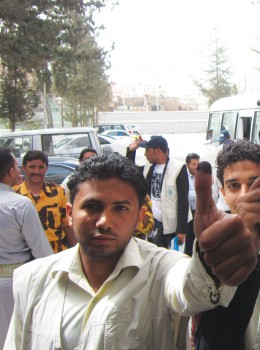
If it takes a catalytic moment to galvanize a large number of people, Yemen has been in the throes of that moment for some time. Though things did come to a head, at least figuratively, in February when the country held its presidential elections. Despite only one candidate on the ballot, Yemenis turned out to vote, begging the question, ‘why?’
For youth such as twenty-one year old Marwa, it was not only the first time they were voting in their lives, but also that they were given the opportunity to engage in the actual electoral process. Prior to the election, the USAID-funded Community Livelihoods Project provided a grant to the Holool Foundation, a Yemeni non-profit dedicated to combating unemployment and poverty, by training 1,000 youth to become elections monitors and observers. Having a multi-fold purpose, the election’s project provided employment to youth while also educating them about electoral processes. Another aim of the project was to bring the voices and ideas of young Yemenis into the public discourse as they are major public policy stakeholders.
“When I was at the voting station, the paper was in front of me but I just stood there staring [as if trying to decide who to vote for]. ‘Are you kidding?!’ said one girl to me who was watching me, “What is this election for anyway? There is only one candidate!’” said Marwa, who served as a monitor for the elections. “I told her that I knew that, but it was still important because by voting, we are showing to other countries that we can follow democratic processes and we are doing it to save Yemen.”
During the election, project youth alternated between being election monitors or observers, so that they would get the full benefit of the experience. Also, another first for Yemen, an SMS system was established so that the public could report on any corruption, fraud or violence at the polls. Youth monitors reviewed the messages on screens with large feeds and filter them. For messages of concern, youth observers called the election center to have monitors investigate the allegations and take action. Messages were also posted on a website so that voters could stay up to date with the election in real time.
In the beginning, I thought no-one would participate and they wouldn’t understand [how to use the SMS service]. I was shocked to see the public participating. It was the first time in Yemen. I felt proud and talked to my friends about it and they said to let us know how to get involved next time around,” said Marwa. “In total we received 9,000 SMS. Even the U.S. Ambassador was surprised! I thought to myself that if we get this many SMS’s when there is only one candidate in the elections — so, what would happen if more than one candidate participated?!”